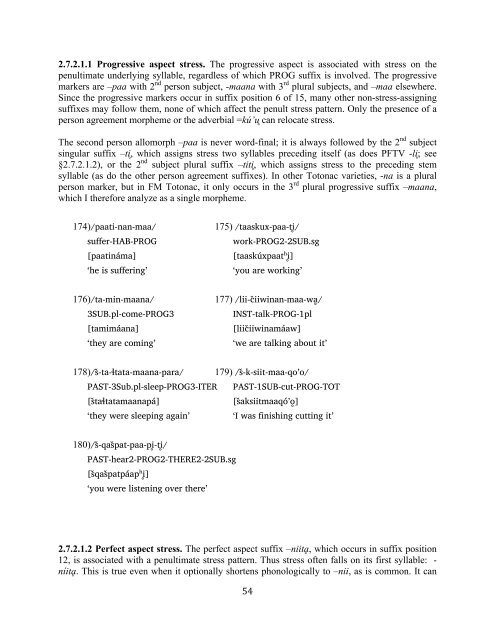The phonology and morphology of Filomeno Mata Totonac
The phonology and morphology of Filomeno Mata Totonac
The phonology and morphology of Filomeno Mata Totonac
You also want an ePaper? Increase the reach of your titles
YUMPU automatically turns print PDFs into web optimized ePapers that Google loves.
2.7.2.1.1 Progressive aspect stress. <strong>The</strong> progressive aspect is associated with stress on the<br />
penultimate underlying syllable, regardless <strong>of</strong> which PROG suffix is involved. <strong>The</strong> progressive<br />
markers are –paa with 2 nd person subject, -maana with 3 rd plural subjects, <strong>and</strong> –maa elsewhere.<br />
Since the progressive markers occur in suffix position 6 <strong>of</strong> 15, many other non-stress-assigning<br />
suffixes may follow them, none <strong>of</strong> which affect the penult stress pattern. Only the presence <strong>of</strong> a<br />
person agreement morpheme or the adverbial =kú’u" can relocate stress.<br />
<strong>The</strong> second person allomorph –paa is never word-final; it is always followed by the 2 nd subject<br />
singular suffix –ti", which assigns stress two syllables preceding itself (as does PFTV -li"; see<br />
§2.7.2.1.2), or the 2 nd subject plural suffix –titi", which assigns stress to the preceding stem<br />
syllable (as do the other person agreement suffixes). In other <strong>Totonac</strong> varieties, -na is a plural<br />
person marker, but in FM <strong>Totonac</strong>, it only occurs in the 3 rd plural progressive suffix –maana,<br />
which I therefore analyze as a single morpheme.<br />
174)/paati-nan-maa/ 175) /taaskux-paa-ti&/<br />
suffer-HAB-PROG work-PROG2-2SUB.sg<br />
[paatináma] [taaskúxpaat%i&]<br />
‘he is suffering’ ‘you are working’<br />
176)/ta-min-maana/ 177) /lii-c"iiwinan-maa-wa&/<br />
3SUB.pl-come-PROG3 INST-talk-PROG-1pl<br />
[tamimáana] [liic"iiwinamáaw]<br />
‘they are coming’ ‘we are talking about it’<br />
178)/s"-ta-#tata-maana-para/ 179) /s"-k-siit-maa-qo’o/<br />
PAST-3Sub.pl-sleep-PROG3-ITER PAST-1SUB-cut-PROG-TOT<br />
[s"ta#tatamaanapá] [s"aksiitmaaqó’o&]<br />
‘they were sleeping again’ ‘I was finishing cutting it’<br />
180)/s"-qas"pat-paa-pi&-ti&/<br />
PAST-hear2-PROG2-THERE2-2SUB.sg<br />
[s"qas"patpáap%i&]<br />
‘you were listening over there’<br />
2.7.2.1.2 Perfect aspect stress. <strong>The</strong> perfect aspect suffix –niit!, which occurs in suffix position<br />
12, is associated with a penultimate stress pattern. Thus stress <strong>of</strong>ten falls on its first syllable: -<br />
níit!. This is true even when it optionally shortens phonologically to –nii, as is common. It can<br />
! )(!

















